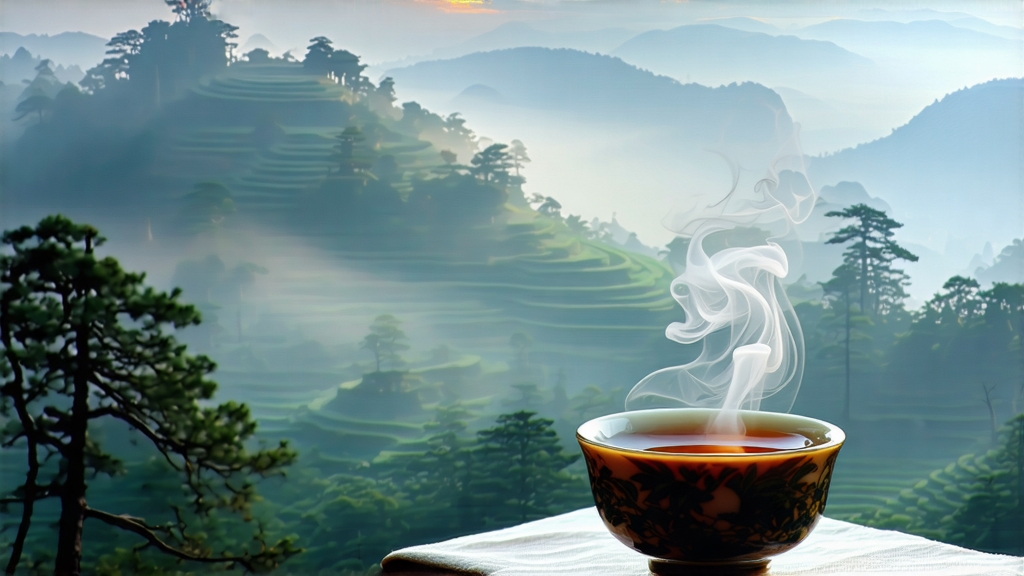
Long before Assam, Ceylon, or Earl Grey were imagined, the first fully oxidised leaf that would become known as “black tea” was born in the rugged Wuyi Mountains of north-west Fujian. Locals simply called it xiao zhong—literally “small cultivar”—to distinguish the indigenous tea bushes from the taller, broad-leafed da zhong varieties. European traders who reached the port of Xiamen in the early 1600s tasted the distinctive smoked version, mispronounced the place-name “Zheng Shan” as “Lapsang,” and the word Souchong (a corruption of “small sort”) was attached to the finer, tender leaves plucked lower on the stem. Thus Lapsang Souchong sailed out of China and into the lexicon of global tea long before the concept of “breakfast tea” ever existed.
The Wuyi massif is a UNESCO dual heritage site where 36 peaks, 99 valleys, and a maze of mountain streams create a humid micro-climate shrouded in cloud for two-thirds of the year. Day-night temperature swings of 15 °C force the tea bushes—mostly the small-leafed Camellia sinensis var. sinensis—to slow their growth, concentrating amino acids and volatile aromatics. The native rocky soil, rich in quartz and granite fragments, drains quickly yet retains just enough moisture to stress the roots, a stress that translates into the mineral depth connoisseurs call “yan yun” or “rock rhyme.” Within this landscape only the triangle bounded by Tongmu Pass, Guadun, and Miaowan villages is recognised as the authentic “zheng shan” (original mountain) precinct; leaves picked outside this zone may be called “wai shan” and are considered lesser cousins.
Two distinct styles of Lapsang Souchong are produced today. The traditional export grade, still scented with pinus taiwanensis smoke, is what most foreigners recognise: a jet-black, slightly resinous leaf that brews into a reddish-brown cup with campfire aromas. Since 2005, however, a new “unsmoked” or “craft” version has emerged for the domestic Chinese market. Master crafters in Tongmu use the same cultivars but omit the final pine-firing, aiming instead to showcase the natural longan-fruit, lychee-honey, and cold-rock nuances that were historically masked by smoke. Both styles share the same plucking standard—one bud and two or three leaves, taken when the top leaf is still curling like a carp’s tail—and both undergo the most labour-intensive black-tea workflow in China.
Withering begins within minutes of plucking. The leaves are spread on large bamboo trays set over warm air ducts fed by charcoal embers; the temperature is held at 30 °C for the first two hours, then lowered to 22 °C so that moisture leaves the leaf slowly, coaxing grassy volatiles to convert into floral precursors. Every twenty minutes the crafter tosses the trays by hand, feeling for the tell-tale limpness that signals 65 % moisture loss. Next comes rolling, but not the violent CTC (crush-tear-curl) used in India; here a 55 cm diameter bamboo kneading basket is rocked gently for 45 minutes, preserving the strip shape and rupturing only 30 % of cell walls so that oxidation proceeds in gradients rather than all at once.
Oxidation is the soul of black tea, and in Tongmu it is still timed by incense sticks rather than clocks. The rolled leaves are piled 8 cm deep in cedar-lined troughs; the wood breathes, allowing micro-fermentation yeasts native to the factory walls to join the enzymatic dance. After one stick (roughly 45 minutes) the leaf edges turn copper, after the second stick the aroma shifts from apple to ripe peach, and only when the third stick is half burned does the master declare the “hong bian” (red edge) complete. A quick blast of 120 °C hot air halts oxidation, locking in a mahogany colour and maltol-rich sweetness.
For traditional Lapsang, the final act is smoking. A shallow pit is dug in the factory floor, lined with brick, and fed with longan-wood charcoal topped by fresh pine branches still dripping resin. The semi-dried tea is placed on sieves